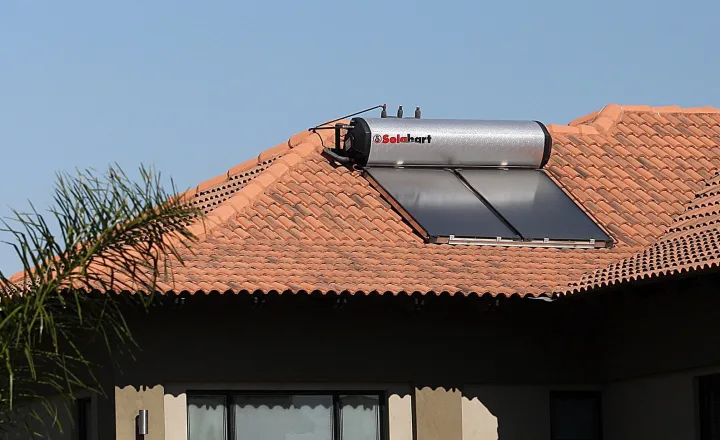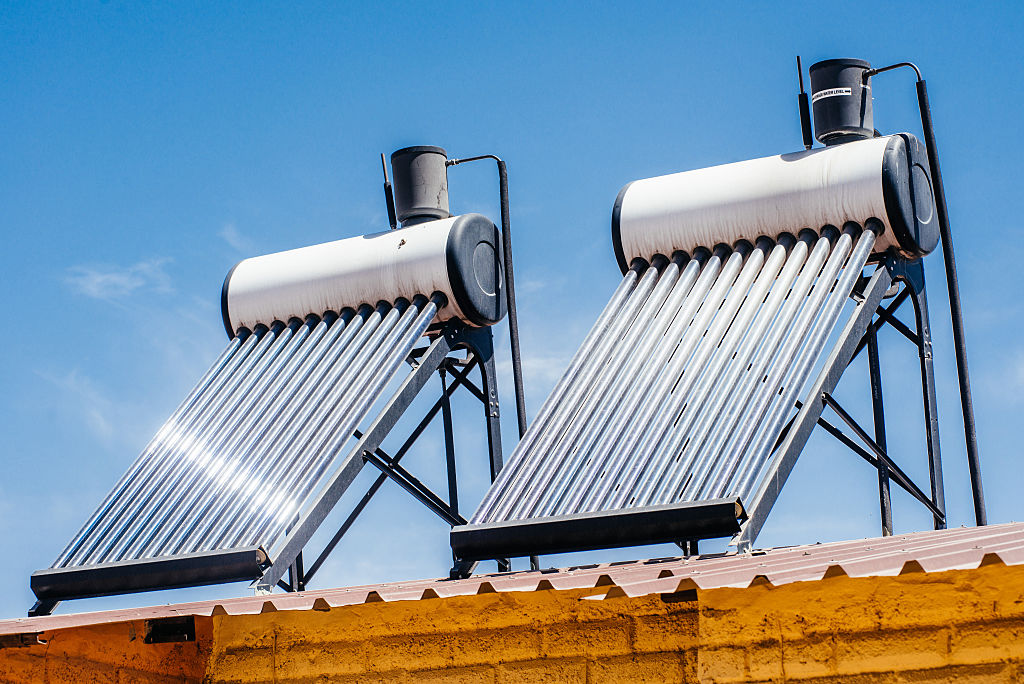LIVE SMARTER
Hot water without electricity – what you need to know about solar water heating

Whether you’re looking to protect your household’s hot water supply from the effects of load shedding and power outages, or simply looking for ways to cut down on your electricity bill, solar water heating might be the right option for you.
‘I always tell my clients the first thing they should do is put their geyser onto solar, because that uses 40% of your electricity. Some people would say 50%, but we average it over the year at just over 40%, because in winter, you’re gonna get less [heat],” says Marc Miller, CEO of the Cape Town-based Waterloo Plumbing.
As mentioned previously in Maverick Life’s article on small-scale solar systems, getting into solar needn’t be an all-or-nothing proposition.
Although not exactly cheap, a modular approach, implemented over time, is still far more accessible than installing everything at once.
There are affordable ways to use solar power to brighten up those load shedding days
What is a solar geyser?
A household solar set-up is typically made up of photovoltaic solar panels that convert sunlight into electrical energy, an inverter that turns it into usable electricity for your household, as well as a battery to store the energy for later use.
However, a solar geyser, also generally referred to as a solar water heating system, does not have a battery or an inverter or a typical photovoltaic solar panel.
It works with solar collectors, which take sunlight, ultraviolet or infrared rays, transform those into heat and use them to heat the water directly.
There are two main types of solar collectors to choose from: a flat-plate collector, or a series of glass evacuated tubes. These are the ones often seen on roofs, with a geyser tank above them.

A flat plate panel on the roof of a home. Johannesburg, South Africa. (Photo by Gallo Images/Sunday Times/Kevin Sutherland)
Flat-plate vs glass evacuated tubes
Both follow a similar principle, in that they collect heat and transfer it to the water. Which one you go with is primarily dependent on which direction your roof faces and how much sunlight it gets.
A flat-plate collector has pipes that run up and down underneath a glass panel which collects the heat and transfers it to the pipes to heat up the water, explains Miller. As the cold water heats up, it rises naturally towards the tank above the panel, filling it with hot water supply for the house.
The glass evacuated tube system doesn’t have water running through its cylindrical tubes. Rather, the tubes are evacuated and a brass rod is inserted. When the rod heats up, it transfers that energy into a manifold at the top, to which all the rods are attached. The water is heated as it runs through the manifold.

Glass evacuated tubes, seen here on the roof of a residential shack in the Alexandra township outside Johannesburg, South Africa. Photographer: Waldo Swiegers/Bloomberg via Getty Images
Which option is right for you?
The sun rises in the east and sets in the west, and we’re in the southern hemisphere. Hence, the solar panel on the roof should be oriented towards the north to get maximum exposure to sunlight, because as Miller explains, “that’ll get you five and a half hours of sun on a full day”. In that case, where the roof is oriented towards the north and is able to get the optimal amount of sunlight, he advises that a flat-plate collector would be the right option.
For homes where a north orientation is not possible, then the glass evacuated tubes, which are far more efficient at collecting energy from ultraviolet rays, would be the right option. “When you don’t have a north-facing roof, then you put those tubes on a west-facing roof, and they absorb ultraviolet rays.”
He doesn’t recommend placing the tubes on a north-facing roof because they are too efficient at collecting heat for the kind of sunlight exposure South African homes get from the north. “Sometimes they heat up to 90°C, and when that happens your geyser basically becomes a bomb that can take your roof off,” he warns.
To avoid this worst-case scenario, the set-up will typically come with a safety valve, so that when the water reaches 90°C, the geyser will let some steam out and some cold water in. However, if those tubes were placed on a north-facing roof during the South African summer, the water would be likely to reach those maximum temperatures regularly, and lead to significant water waste as the system lets off steam and mixes in more cold water to cool it down, explains Miller.
“And if you had to put a flat-plate panel on a west-facing roof, you wouldn’t have enough hot water, because it’s not efficient enough. So it’s a flat plate on the north-facing roof and tubes on a west-facing roof.”
Should you install a brand-new solar geyser or retrofit a panel to your existing geyser?
Unlike a new system, where the geyser is placed above the panel so that the hot water naturally rises to it, a retrofitted panel would likely mean that the geyser, which would be your existing normal electric geyser, is below the panel, between the roof and the ceiling, or fitted on a wall.
In this case, you would then also need to install a pump to push the hot water into the geyser.
“To give you an idea of how much retrofitting might cost in comparison to a new system:
“If you’re thinking at a 200-litre tank, you’re looking at about R30,000 for a brand-new complete installation, including a panel and a tank. If you want to retrofit your old geyser, you’re looking at about R22,000, and that would cover the fitting, the panel and the pump, basically everything,” says Miller.
Pros and cons
Due to the system’s dependence on the sun, Miller advises that homeowners always keep their Eskom connection as back-up, mainly because in winter, when there might be minimal sun exposure, it is likely that far less heat will be collected.
So, unlike a gas geyser, as explained in a previous Maverick Life article, the solar geyser would be less effective for a home that is completely off-grid.
Choose the right-size gas geyser to save on electricity and money
That said, considering the amount of sun South Africa gets, Miller says that homeowners would still reap significant savings over time from solar heating, in addition to the convenience of hot water even during extended rolling blackouts and other potential power outages.
“If you take into consideration the 40% saving on your electricity bill over the year, it takes approximately three years to pay back the cost of a retrofitted system in savings, and about four to five years for a brand-new system to basically pay for itself,” says Miller.
Last, he stresses that should you go the solar route for water heating, “it has to be installed by a qualified solar installer. So, just because one is a plumber, doesn’t mean they can install solar. They’ve got to do an added [qualification] to install solar. You’ve also got to make sure you get a certificate of compliance for your system. It must be compliant by law.” DM/ML
Disclosure: This article has been edited from the original version, to correct an error in the technical explanation about solar water heating.





















 Become an Insider
Become an Insider
Be aware that having a Geyser outside on the roof needs extra insulation for the cold south easter.
In my case the geyser temperature was reading about 55 degree in the evening but 30 degree in the morning nullifing the solar system. I had to put extra insulation over the geyser unit to solve this.
fyi, its not just in the southern hemisphere that “the sun rises in the east and sets in the west”.
Thank you for this insightful and helpful article! With all the “inverter” (meaning inverter but first of all storage battery) craze going on (which BTW makes loadshedding worse, unless the battery is fed by solar panels, i.e. it is a photovoltaic system) I am amazed how the “low-hanging fruit” of solar water heating is largely ignored. It is great to have hot water irrespective of electricity (except for a few weeks a year in Cape Town), it saves lots of money (payback time is probably less than 10 years), and it allows a much smaller photovoltaic setup if you can take hot water out of the calculation.
Well done and at last! Solar water heating is the lowest hanging fruit for saving energy and a kWh saved is the same as a kWh generated. Solving the power crisis would be greatly assisted if every house had a solar water heating unit, as they do typically save between 35% and 55% of the domestic electricity bill. For the consumer the payback on a retrofit, using the existing electric geyser can be as little as two years or less. Although there are a number of technical errors in the explanation, particularly the schematic, the message is clear, solar water heating should be the first step in getting off the grid, saving money and helping mitigate climate change.
Mali, good article. Check on that illustration with the caption about glass tube collectors, the common commercial version has the water flowing through the manifold on top, not through the tube. The through-tube type is very uncommon and I have only seen them in research systems.
From hard experience, beware of who installs your solar water heater, use a reputable company and get real references. Many wannabe installers out there piggyback on their plumbing or electrical core business and install systems they do not understand. Natural flow systems are not allowed in many complexes because of their ‘poor aesthetics’, so people go for the pumped system, which is another bag of horrors if your installer is not properly trained and informed.
The article missed the critical difference between pumped and thermosyphon systems. The former simply do not work with load shedding but are still one of the most common systems intalled as a retrofit
Tube collectors work fine when facing north, the geyser can get hot (up to 80 degrees) but it doesn’t turn into a “bomb” as there are pressure relief valves on the geyser and on the syphon system.
Just make sure your system uses a solar panel to power the pump for circulating the water during load shedding. Its an extra option costing a few hundred backs
Don’t forget solartech a fantastic company with fantastic after service that never disappointed. We had our geyser installed inside our house panels on roof.
In Gauteng we generally have sun every day over winter, so no problem getting enough hot water. I’ve had a north facing 200l evacuated tube system for almost 11 years. It is very efficient, so I have used kreepy crawly pipes to cover about 6 of the 20 tubes in summer to stop it boiling! But it also means that I’ve not spent a cent for hot water in about 3 years.
In Johannesburg and areas where the winter night temperature can drop below zero and quite fast, water in the the flat plate collectors, also known as direct connectors can freeze and the pipes burst. Evactuated tubes, or indirect collectors don’t freeze.
You can also build your own solar geyser with black 15 mm ultraviolet proof PVC pipe. I tested it and it heats the water up to above 42 degrees in the middle of the day. But the pump will still have to be part of the system so that, when the sun goes away, the hot water is already inside the geyser.
Our solar water heater in Pretoria saves much electricity. Although it does have an electric element as back-up if needed, that element is normally switched off, and was not used at all during 2022!
But evacuated tube collectors have a hollow partly evacuated device called a heat pipe — NOT a brass rod — down the middle to transfer heat to the manifold at the top. A brass tube’s lenghtwise thermal conductivity is far too low, while that of a heat pipe (also called a thermal superconductor) is more than a thousand times as much.
It works by evaporating an enclosed fluid, vapour moving up to the manifold, condensing there, giving up the huge heat of condensation and the liquid moving down to repeat the cycle
Right Wolfgang. I live in CT and in the middle of winter there is a weak spot for solar. I have a manual switch on my solar geyser to boost the heat when needed, but I also have a solar PV system so still save on electricity.
Don’t buy a fancy car, get an ordinary one and get solar for free!
Thanks for your article! Are you going to add another instalment on heat pumps? This is another way of reducing reliance on the traditional electric geyser and can be integrated into a solar PV set up.
I have installed two retrofits on existing geysers in my homes over the years. Both were simple and cheap installations. The second used a small PV panel to power the pump, and so is simpler and works in load shedding. Perfect. No temperature sensors required.
I had one significant problem with both installations, that was reverse thermo syphoning at night. Ie with the geyser sitting below the panel, filled with hot water from the day’s sun, as night fell and the roof panel cooled, the less dense hot water found a path through the pump, up to the panel, where it cooled and dropped back into the geyser via the pump suction. Ie, at night the system lost all the heat it had gained from the day.
The flows involved are very low and I found that a normal non return valve could not stop this problem. I solved it by fitting a specialised antisyphoning valve. This has worked perfectly for about 10 years, but does need descaling from time to time.
I contacted various installers at the time and none seemed to be aware of the issue. I also contacted SARS who claimed to know about the issue, but said it was outside their safety remit.
I am not sure how prevalent this issue is, but I suspect a lot as I had 2 hits out of 2. To check, first you will notice a high, unexpected rate of water cooling at night. Second, go up to your panel on the roof an hour or two after sunset, and feel if it is hot.
Despite this issue, I would generally recommend the refit option.
In September 2019, I installed a Solar Photovoltaic water heater which has 3 x 315W panels for a 150l geyser. The cost was R16k installed. It would be interesting to see an article that mentions this option as well.
The thermodynamic efficiency converting light to electricity is typically 25%, but if one restricts the time a geyser is switched on to only when needed, PV powered geysers can have similar efficiencies to solar geysers. As a general principle, it is not a good idea to generate electricity to then heat anything (geyser, stove, air), but it sure is convenient.
Should you consider a solar power system in the near future, I would not recommend to invest in a separate solar heating geyser. A domestic rooftop solar system has got midday excess power which easily can heat a normal geyser system. A “Geyserwise “ type controller together with a reduced heating element (say 2kw) will reduce any peak power drawn from your inverter and will still heat your geyser within 1-2 hrs of solar power which otherwise most probably would be wasted.
As already mentioned by Andries Herholdt and Chris Marshall in the comments, there is the possibility of using a dedicated PV system to heat your hot water. A unique system utilises two heating elements, one being low voltage (isolated from the property’s electrical system), and the other standard 220V. The benefit here is that, when there is insufficient sun, the system can still use grid supplied electricity to heat water in the cylinder (and vice versa). A second benefit is that, in many cases the existing cylinder is retained in its position, and low voltage electricity fed to it from wherever the PV’s are best located (for highest efficiency). All of this from a Cape Town based company, GeyserWise, with distributers and qualified installers all around the country. The installation is approved by the City of Cape Town, and the company will issue the appropriate Certificate of Compliance (CoC). I’d presume that other municipalities are treating it similarly. Whilst, possibly, not the cheapest solution, it does obviate some of the add-on costs and repair and maintenance risks of other solar-thermal systems. As a partner in a firm of architects, many of our clients have been going this route.
The Alexandra geyser illustrated is a low pressure system – they are relatively inexpensive (R4-10k , depending on capacity), and relatively foolproof. The small tank at the top is a filler tank, much like a toilet cistern. It is an open system, and so cannot explode. We have had one since 2005 without problems, and it boils every day in summer.